
The Solar-Terrestrial Centre of Excellence (STCE) is a collaborative network of the Belgian Institute for Space Aeronomy, the Royal Observatory of Belgium and the Royal Meteorological Institute of Belgium.
 |
Published by the STCE - this issue : 30 Jul 2015. The Solar-Terrestrial Centre of Excellence (STCE) is a collaborative network of the Belgian Institute for Space Aeronomy, the Royal Observatory of Belgium and the Royal Meteorological Institute of Belgium. |
| Archive of the newsletters | Subscribe to this newsletter by mail |
As discussed in a previous news item (4 June 2014, see http://www.stce.be/news/253/welcome.html), both STEREO spacecraft are on the other side of the Sun as seen from Earth. This is called a superior solar conjunction - see diagram underneath for the position of both spacecraft. For some time, each spacecraft is blocked by the solar disk making it impossible to communicate with it or receive data or images from it. On top of that, being so close to the Sun, the radio signals are disturbed by the solar radio emission for quite some time before and after the conjunction.
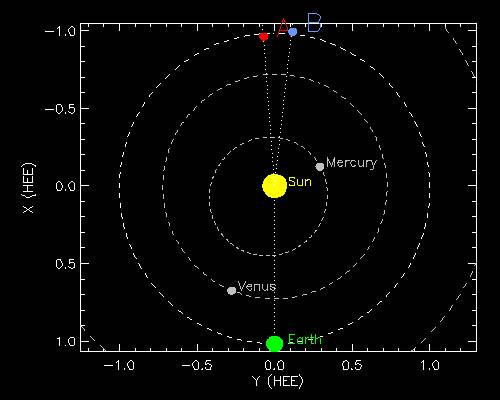
For STEREO-A, the radio silence is finally over. Starting 8 July, the STEREO operations team gradually awakened STEREO-A from its hibernation using the powerful antennas from the Deep Space Network. Instruments and cameras were gradually turned back on. The first extreme ultra-violet and coronagraphic images became available on 11 July, and were put online over the next few days. STEREO-A's current location provides a view on which active regions are about to turn over the east limb as seen from Earth and thus will become visible to us. The imagery is also important to determine if any coronal mass ejections are earth-directed or not.
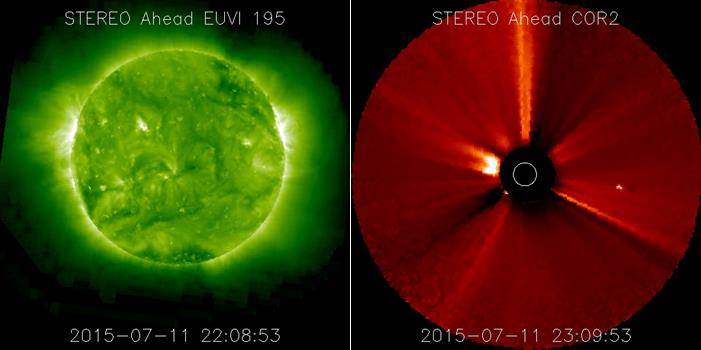
So it's good to have at least one of the twins back online. The situation for STEREO-B is more problematic. Indeed, STEREO-B is already offline since 01 October 2014 after contact with the spacecraft was lost following two simultaneous failures in the attitude control system (http://stereo-ssc.nascom.nasa.gov/behind_status.shtml). Recovery efforts are currently planned for later this year. Hopefully they are successful such that the views of the entire solar surface, such as the map underneath, will remain available for a few more years. The situation can be followed up at http://stereo-ssc.nascom.nasa.gov/new.shtml
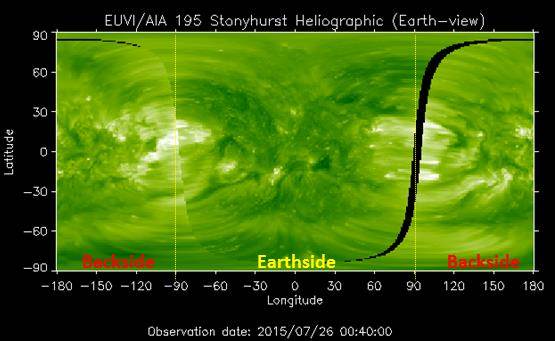
The STCE Annual Report 2013 is now available at http://www.stce.be/annualreport.php
It is a compilation of the activities done in 2013 within the frame of the Solar-Terrestrial Centre of
Excellence (STCE). This report continues the style from the previous editions. Hence, as it is targeting a more general public, it presents only a selection of the 2013-activities in easy-to-digest summaries. These summaries emphasize the intense collaboration between the institutes at the Space Pole, as well as with our external partners.
The 2013 report features articles on solar and space weather activity, the Open Doors at the Space Pole, the 10th European Space Weather Week, a new value for the solar constant, BRAMS, PICASSO, ionospheric monitoring, quality assessment of ozonesonde data, and so on...
We hope you enjoy it and wish you a happy reading!
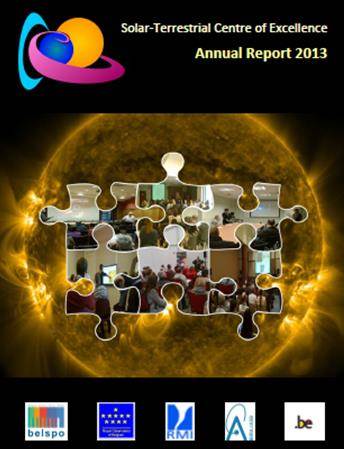
Solar activity was very low for most of the week, with only 4 low-level C-class flares observed. These were all produced by NOAA 2389, with the strongest being a C2.6 flare peaking on 24 July at 17:55UT. NOAA 2390 was the most prominent sunspot region by the end of the week, but remained flare inactive. No Earth-directed coronal mass ejections (CMEs) were observed.
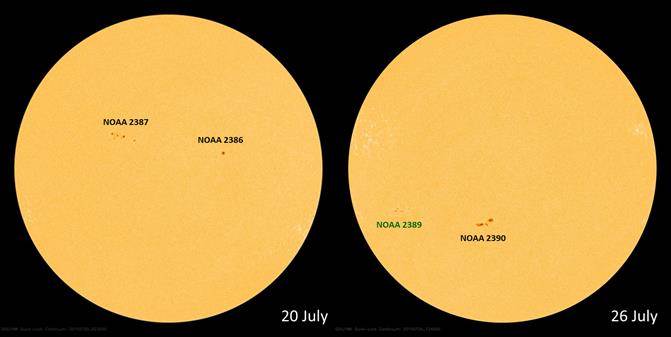
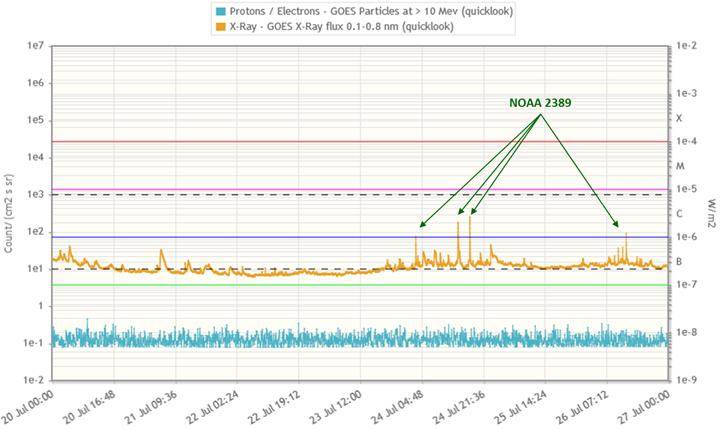
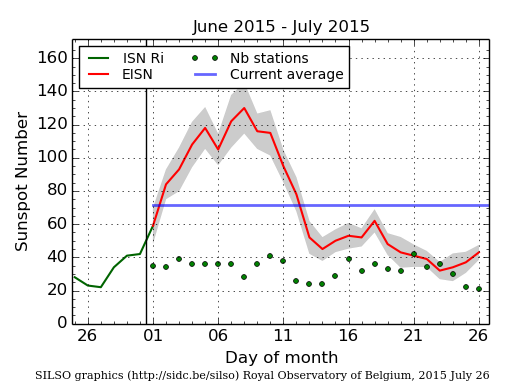
Daily Estimated International Sunspot Number (EISN, red curve with shaded error) derived by a simplified method from real-time data from the worldwide SILSO network. It extends the official Sunspot Number from the full processing of the preceding month (green line). The plot shows the last 30 days (~ one solar rotation). The horizontal blue line shows the current monthly average, while the green dots give the number of stations included in the calculation of the EISN for each day.
Solar flare activity fluctuated between very low and low during the week.
In order to view the activity of this week in more detail, we suggest to go to the following website from which all the daily (normal and difference) movies can be accessed: http://proba2.oma.be/ssa
This page also lists the recorded flaring events.
A weekly overview movie can be found here (SWAP week 278).
http://proba2.oma.be/swap/data/mpg/movies/weekly_movies/weekly_movie_2015_07_20.mp4
Details about some of this week's events, can be found further below.
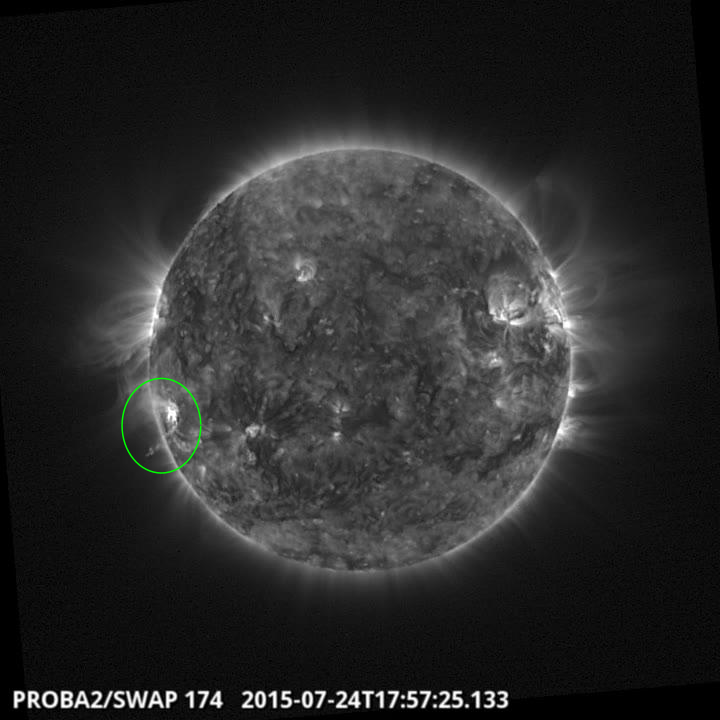
C-flare on the east limb @ 17:57 SWAP image
Find a movie of the events here (SWAP movie)
http://proba2.oma.be/swap/data/mpg/movies/20150724_swap_movie.mp4
The Earth environment was under the influence of a moderate-speed stream of a positive coronal hole (CH) on 21 July ("CH1" on figures underneath), with maximum wind speeds attaining only about 480 km/s. Only unsettled geomagnetic conditions were recorded. During the afternoon of 22 July, Earth experienced the glancing blow of the 19 July coronal mass ejection (CME), associated with a filament eruption near the southwest limb. Wind speeds increased to 450 km/s, and a persistent southward oriented Bz of -11 nT was recorded from 03:00 till 07:00UT on 23 July. This resulted in a minor geomagnetic storm episode (06:00-09:00UT on 23 July).
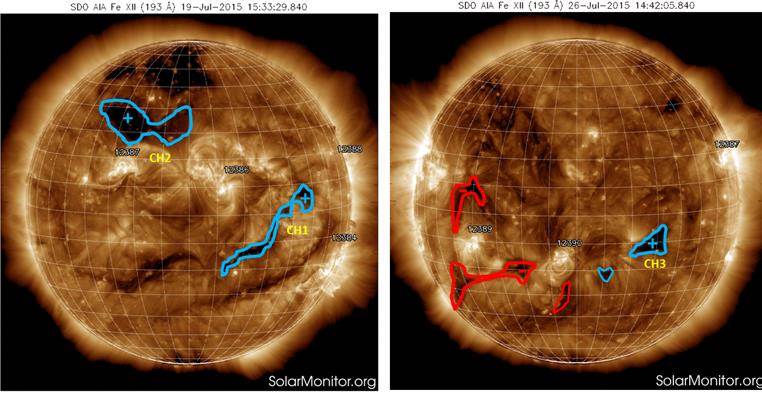
After that, the Earth was influenced by a positive CH on more northern latitudes ("CH2"; 25-40 degrees) till early on 26 July. Wind speeds were highest late on 23 July, with values between 500-550 km/s. Active geomagnetic conditions were observed late on 23 July and in Dourbes also on 25 July. At the end of the week, solar wind speed started a gradual increase from 400 km/s to values near 500 km/s under the influence of another positive CH (small and near the solar equator; "CH3").
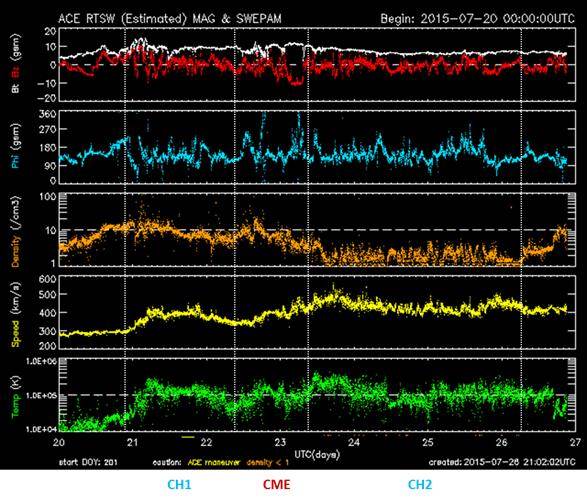
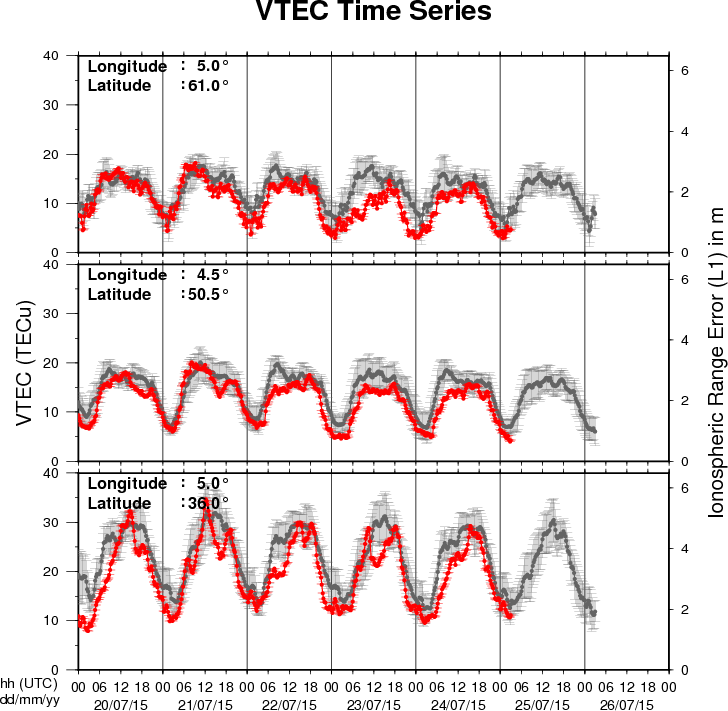
The figure shows the time evolution of the Vertical Total Electron Content (VTEC) (in red) during the last week at three locations:
a) in the northern part of Europe(N61°, 5°E)
b) above Brussels(N50.5°, 4.5°E)
c) in the southern part of Europe(N36°, 5°E)
This figure also shows (in grey) the normal ionospheric behaviour expected based on the median VTEC from the 15 previous days.
The VTEC is expressed in TECu (with TECu=10^16 electrons per square meter) and is directly related to the signal propagation delay due to the ionosphere (in figure: delay on GPS L1 frequency).
The Sun's radiation ionizes the Earth's upper atmosphere, the ionosphere, located from about 60km to 1000km above the Earth's surface.The ionization process in the ionosphere produces ions and free electrons. These electrons perturb the propagation of the GNSS (Global Navigation Satellite System) signals by inducing a so-called ionospheric delay.
See http://stce.be/newsletter/GNSS_final.pdf for some more explanations ; for detailed information, see http://gnss.be/ionosphere_tutorial.php
Start : 2015-08-22 - End : 2015-08-23
On August 21, 2017, a total eclipse of the Sun will cross the
United States from coast to coast, giving tens of millions of
people in a 70-mile-wide path from Oregon to South Carolina a
chance to see the solar corona and experience "darkness at midday."
Outside the path of totality, all of North America will experience
a partial eclipse. This event, the first total solar eclipse to
touch the US mainland since 1979 and the first to span the
continent since 1918, presents a unique opportunity to excite
people about science and connect them personally to the cosmos, as
well as to conduct several important scientific observations. We
are a working group dedicated to the science and public outreach of
this unique event.
The next Eclipse 2017 workshop will take place in Portland,
Oregon, on Saturday and Sunday, August 22 and 23, 2015, at the
Oregon Museum of Science and Industry, hosted by the director Jim
Todd. Saturday's morning session will be open to the public at
large, with presentations to inform the public about the total
solar eclipse of 2017. The Saturday afternoon and Sunday sessions
will follow a schedule similar to those at previous workshops with
presentations alternating with smaller group discussions, and a
final presentation of small group results.
Website:
https://aas.org/education/outreach/eclipse-2017
Start : 2015-08-24 - End : 2015-08-28
Following the success of previous CESRA summer schools, Glasgow
University is hosting the 2015 CESRA radio summer school on the
24-28th August 2015. The Glasgow CESRA Summer School 2015 is your
chance to learn about the exciting world of solar radio
physics.
The school is open to solar radio physicists including PhD
students and early career researchers. The school will cover the
essential elements of theory, modelling and data analysis and will
feature lectures and tutorials. Students will have the opportunity
to meet and discuss research topics with their peers together in an
informal atmosphere.
Website:
http://www.astro.gla.ac.uk/cesra2015
Start : 2015-10-26 - End : 2015-10-29
The IRIS-5 workshop will be conducted at the Inter-University
Centre for Astronomy and Astrophysics (IUCAA), Pune, India from
October 26-29, 2015. This workshop is mainly aimed at the
participants who could not attend IRIS-4, which is being held at
Boulder, USA. Therefore, set up of the IRIS-5 workshop would be
essentially be very similar to that of IRIS-4.
The main aim of the workshop is to introduce the Interface
Region Imaging Spectrometer (IRIS) to students and young post docs.
This would be done through tutorials on IRIS data analysis, physics
of optically thick radiative transfer, MHD simulations of the solar
atmosphere related to IRIS and hydrodynamic simulations of flares.
There will be lectures as well as hands on sessions.
Website:
http://www.iucaa.ernet.in/~solar/Welcome.html
Start : 2015-11-13 - End : 2015-11-13
With the launch of NASA's Solar Dynamics Observatory (SDO)
mission on 02/11/2010, researchers in solar physics have entered
the era of Big Data. The Atmospheric Imaging Assembly (AIA)
instrument on SDO provides imaging data and the Helioseismic and
Magnetic Imager (HMI) instrument on SDO provides magnetic field
data. Both instruments record data at a high spatial resolution and
a time cadence, amounting to about 1 Petabyte of scientific data
each year. The Big Data challenges in Solar Astronomy are expected
to grow even further with the inauguration of the NSF funded Daniel
K. Inouye Solar Telescope (DKIST), currently under construction in
Hawaii. This telescope is expected to generate: 3-5 Petabytes of
data per year.
The STCE Annual Report 2013 is a compilation of the activities done in 2013 within the frame of the Solar-Terrestrial Centre of Excellence (STCE). This report continues the style from the previous edition. Hence, as it is targeting a more general public, it presents only a selection of the 2013-activities in easy-to-digest summaries. These summaries emphasize the intense collaboration between the institutes at the Space Pole, as well as with our external partners. We hope you enjoy this report, which features articles on solar and space weather activity, the Open Doors at the Space Pole, the 10th European Space Weather Week, a new value for the solar constant, quality assessment of ozonesonde data, BRAMS, PICASSO, ionospheric monitoring, and much more... Happy reading!
http://www.spaceweather.eu/en/repository/show?id=584